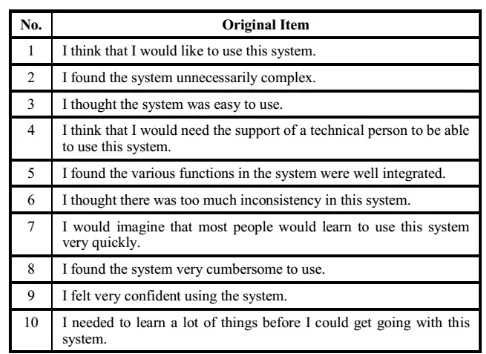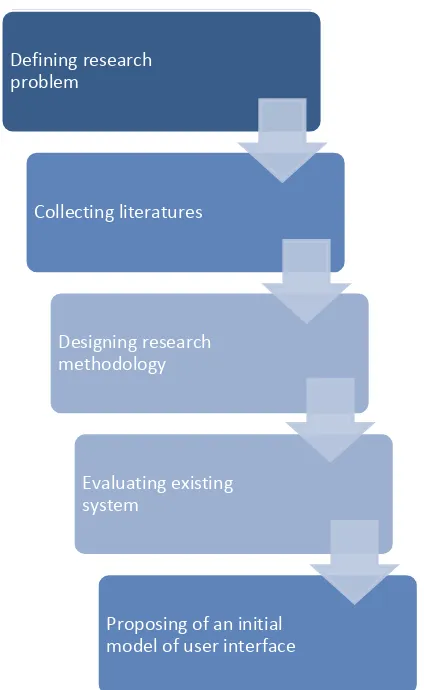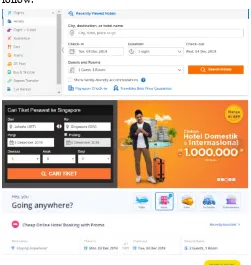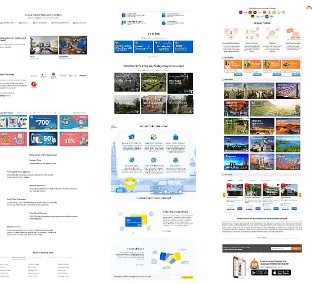DOI : https://doi.org/10.32628/CSEIT195645
A Preliminary Study : User Interface Design of Online Travel
Booking Application
Nur Ani
Faculty of Computer Science, Universitas Mercu Buana, Jakarta Barat, Indonesia
ABSTRACT
In recent years, area of software product development not only focused on features but also usability aspect. Software product must deliver the best user interface since it launched. To achieve this aim, the developers should realize application with suitable features and good interface based on user needs. This paper aim is to present user interface design for online travel booking application. This research is consisted of five phases, i.e. defining research problem, collecting literatures, designing research methodology, evaluating existing system, proposing of an initial model of user interface. As the research result, we proposed user interface of initial design that is consisted of main menu, content sliders, online booking form, body and footer. Main menu is designed by providing menu flight, hotel, train, travel add-ons, promo, register, login, and contact. Content sliders contained image about promo and favorite destination. The online booking is provided for many types based on order such as flight service, hotel service, trains service and so forth. The body of web contained information about favorite destination, promo and best offers. For footer presented social media, about, support and many more.
Keywords: User Interface Design, Online Travel Booking, UI Reengineering
I. INTRODUCTION
Nowadays, the business area of software not only focused on features but also user interface design aspects. The properties of software must deliver the best user interface since it launched. To realize this purpose, the developers should realize software with suitable features and excellent user interface based on user needs [1][2].
In the previous study, to collect user feedback about interface design can be used interactive method, i.e., interview, joint application design (JAD), and survey using a questionnaire. Those methods are named interactive approach because the interaction between respondent and researchers based on some issues is
needed to achieve the aim of the information collection. [3].
Existing research on the user interface design purposed by [4]–[7]. Franco et al. a web-based graphical food frequency assessment system [4], Little et al. gathered feedback about mobile application for patients rehabilitating [5], Dexheimer et al. evaluated usability of Self-Monitoring Activity-Restriction and Relaxation Treatment (SMART) application for youth with morbidity associated with mild traumatic brain injury (mTBI) [6] and many more.
interface recommendation for online travel booking application that is suitable with characteristics of Indonesian people.
II. LITERATURE REVIEW
A. Related Works
Related works of this research includes research about usability evaluation and user interface design.
Many studies about usability evaluation using system usability scale have been done by researchers through translating questionnaire items to many languages, for examples Polish [9] and Bahasa [10], Portuguese [11], Slovene [12], Persian [13] and Germany [14].
The recent study of the interface design has been complete by researchers, for example mobile interface to content management system based on HTML5 and Drupal: a case study [15], mobile business applications designing user interface and architecture [16] and mLUX: usability and user experience development framework for m-learning [17].
Moreover, study of user interface design and evaluation has been done by Franco et al. for evaluating a web-based graphical food frequency assessment system [4], Little et al. for gathering feedback about mobile application for patients rehabilitating [5], Dexheimer et al. for evaluating usability of Self-Monitoring Activity-Restriction and Relaxation Treatment (SMART) application for youth with morbidity associated with mild traumatic brain injury (mTBI) [6] and Noprisson et al. for evaluating m-Government application [7].
B. Online Travel Booking Application
The growth of information technology and communication (ICT) lead to people conducted all transaction by online network, including travel booking. Online travel booking has been started by online travel agents (OTAs) (e.g., Travelocity, Priceline in the 1990s [18]. In Indonesia, online travel booking more famous after several online travel
booking application is launched, e.g. Traveloka, Tiket and PegiPegi. with limited respondents [20]. This questionnaire is consisted of 10 (ten) simple statements, which are, represented all aspects of usability as shown in Figure 1 below.
Figure 1. The original item of system usability scale (SUS) in Bahasa Indonesia [19]
For counting the SUS score, we should focus on odd and even number of questionnaire items. For odd number (1, 3, 5, 7, and 9), SUS score is the selected scale value minus 1. For even number (2, 4, 6, 8 and 10), SUS score is 5 (five) minus the selected scale value. All SUS scores are counted its averages to ease interpretation of the result [19].
III.METHODOLOGY
This section will be presented research phases, data collection and research instrument.
A. Research Phase
proposing of an initial model of user interface, which are presented in Figure 3.
Figure 2. Research phase
First, defining research problem and research object is conducted by reading research paper from research databases. Second, collecting related literatures is needed to gain knowledge in order to complete research and tackle research problem. Third, designing research methodology is important to arrange research activities completed on schedule and systematically. Then, based on feedback of data from online questionnaire by involving participants and reviewing design of existing system, we proposed initial model of online travel that will be used as general model for next research
B. Data Collection
Research data is collected in two phases including:
1. Data for existing system evaluation
A random sample of 1,254 respondents was drawn from Jakarta, Indonesia. We used two established criteria to find respondents in this research. First, respondent must be familiar with Internet and smartphone. Second, respondents must have experience about online travel booking application in Indonesia.
2. Data for proposing an initial model
In this study, we referred to three online travel booking application, including Traveloka.com, Tiket.com and PegiPegi.com to proposed initial model of user interface design.
IV.RESULTS AND DISCUSSION
A. Feedback of Existing System Evaluation
The interpretation of research result based on data from online questionnaire by involving 1,225 participants. Respondents were asked to answer questionnaire items based on their experience using online travel booking application.
This research is important to inspect and review current online travel booking application in order to get recommendation about content and design of application which is easy to use [21].
The overall SUS scores is only 56.13 based on 1,225
participant’s perspective. This score result of SUS is
below 68 (average) so that it must be improved.
service easily, application should integrate other user data to reduce some errors in filling data for booking process, time for completing payment should be more
than 45 minutes because many respondents don’t have
internet banking.
Figure 3. Main menu of existing system
B. Initial Model of User Interface
Traveloka present more menus than PegiPegi.com and Tiket.com. Moreover, PegiPegi.com and Tiket.com designed their menu only focus for their main business,
including “flight”, “hotel” and “train” reservation.
However, PegiPegi.com did not provided the language option in their header. Our proposed model for main menu can be seen below.
Figure 4. Main menu of proposed system For content sliders setting, three of systems provides image slide-show with navigation tools that prsenst different type of information, mostly about the current promo and favourite destination as can been as follow.
Figure 5. Content sliders of existing system
The existing system also present online booking form in their main page. The systems provide the different form based on their service, for instance, flight service, hotel service, trains service and so forth as depicted as follow.
Figure 6. Booking form of existing system
Figure 7. Web body of existing system For the footer design, the existing system present
many information that did not present in main menu for example social media, about, support and many more as depicted as follow.
Figure 8. Footer of existing system
Based on feedback of data from online questionnaire by involving 1,225 participants and reviewing design of existing system, we proposed initial model of online
travel that will be used as general model for next research. The proposed model can be seen in Figure below.
V.CONCLUSION
This research aim is to represent insight about interface recommendation for online travel booking application that is suitable with characteristics of Indonesian people. Based on the research result, we found User interface of initial design consisted of main menu, content sliders, online booking form, body and footer. Main menu is designed by providing menu flight, hotel, train, travel add-ons, promo, register, login, and contact. Content sliders contained image about promo and favourite destination. The online booking is provided for many types based on order such as flight service, hotel service, trains service and so forth. Body of web contained information about favourite destination, promo and best offers. For footer section presented social media, about, support and many more.
Management,” J. Theor. Appl. Inf. Technol., vol. 75, no. 2, 2015. Graphical Food Frequency Assessment System: Design , Development and Usability Metrics Corresponding Author :,” JMIR Hum Factors, vol. 4, no. 2, 2017.
[5] J. R. Little, H. H. Pavliscsak, M. Cooper, L.
Goldstein, J. Tong, and S. J. Fonda, “Usability of
a Mobile Application for Patients
Rehabilitating in their Community,” J. Mob. Technol. Med., vol. 6, no. 3, pp. 14–24, 2017. [6] J. W. Dexheimer, B. G. Kurowski, S. H. Anders,
Nicole McClanahan, S. L. Wade, and L.
Babcock, “Usability evaluation of the SMART application for youth with mTBI,” Int J Med Inf., vol. 97, pp. 163–170, 2017.
[7] H. Noprisson, N. Husin, M. Utami, Puji Rahayu,
Y. G. Sucahyo, and D. I. Sensuse, “The Use of a Mixed Method Approach to Evaluate
m-Government Implementation,” in 2016
International Conference on Information Technology Systems and Innovation (ICITSI), 2016.
[8] K. K. Wijaya, “GrabBike VS Go-Jek, Siapa yang
Mencapai Pertumbuhan Paling Cepat?,” 2015.
[Online]. Available:
https://id.techinasia.com/pertumbuhan-grabbike-vs-go-jek. [Accessed: 01-Nov-2017]. [9] A. Borkowska and K. Jach, “Pre-testing of
Polish Translation of System Usability Scale
(SUS),” in Advances in Intelligent Systems and Computing, L. Borzemski, A. Grzech, J.
Świątek, and Z. Wilimowska, Eds. Cham:
Springer, 2017.
[10] Z. Sharfina and H. B. Santoso, “An Indonesian adaptation of the System Usability Scale (SUS),”
in Advanced Computer Science and Information Systems (ICACSIS), 2016 International Conference on, 2016.
[11] A. I. Martins, A. F. Rosa, A. Queiros, A. Silva,
and N. P. Rocha, “European Portuguese Validation of the System Usability Scale (SUS),”
in 6th International Conference on Software Development and Technologies for Enhancing Accessibility and Fighting Infoexclusion, 2015. [12] B. Blazica and J. R. L. A, “Slovene translation of
the System Usability Scale: the SUS-SI,” Int. J. Hum. Comput. Interact., vol. 31, no. 2, pp. 112–
[13] I. Dianar, Z. Ghanbari, and M. Asghari
Jafarabadi, “Psychometric properties of the
Persian language version of the System
Usability Scale,” Heal. Promot. Perspect., vol. 4, no. 1, pp. 82–89, 2014.
[14] K. Lohmann and J. Schäffer, “System Usability
Scale An Improved German Translation of the Questionnaire,” CoreMedia AG, 2013. [Online]. Available:
https://minds.coremedia.com/2013/09/18/sus- scale-animproved-german-translation-questionnaire/. [Accessed: 13-Jan-2018]. [15] T. K. H. Priya, K. Divya, M. Somasundaram, J.
Hima, and S. P. Karthikeyan, “Mobile interface
to content management system based on
HTML5 and Drupal: a case study,” Int. Conf. Softw. Eng. Mob. Appl. Model. Dev. (ICSEMA 2012), pp. 15–15, 2012.
[16] S. Braun, S. Hess, T. Lenhart, D. Magin, and M.
Naab, “Mobile Business Applications Designing
User Interface and Architecture,” Icse, pp. 132–
133, 2015.
[17] A. Dirin and M. Nieminen, “mLUX: Usability
and User Experience Development Framework for M-Learning,” Int. J. Emerg. Technol. Learn., vol. 5, no. 4, pp. 1–10, 2015.
[18] A. Inversini and L. Masiero, “Selling Rooms
Online: The Use of Social Media and Online
Travel Agents.,” Int. J. Contemp. Hosp. Manag., vol. 26, no. 2, pp. 272–292, 2014.
[19] J. Brooke, “SUS - A quick and dirty usability
scale,” 1986.
[20] A. Bangor, P. T. Kortum, and J. T. Miller,
“Determining what individual SUS scores mean: Adding an adjective rating scale,” J. Usability Stud., vol. 4, no. 3, pp. 114–123, 2009.
[21] R. L. B. Bai, “How do the preferences of online
buyers and browsers differ on the design and content of travel websites?,” Int. J. Contemp. Hosp. Manag., vol. 20, no. 4, pp. 388–400, 2008.
Cite this article as :
Nur Ani, "A Preliminary Study: User Interface Design of Online Travel Booking Application", International Journal of Scientific Research in Computer Science,
Engineering and Information Technology
(IJSRCSEIT), ISSN : 2456-3307, Volume 5 Issue 6, pp. 261-267, November-December 2019. Available at doi : https://doi.org/10.32628/CSEIT195645



